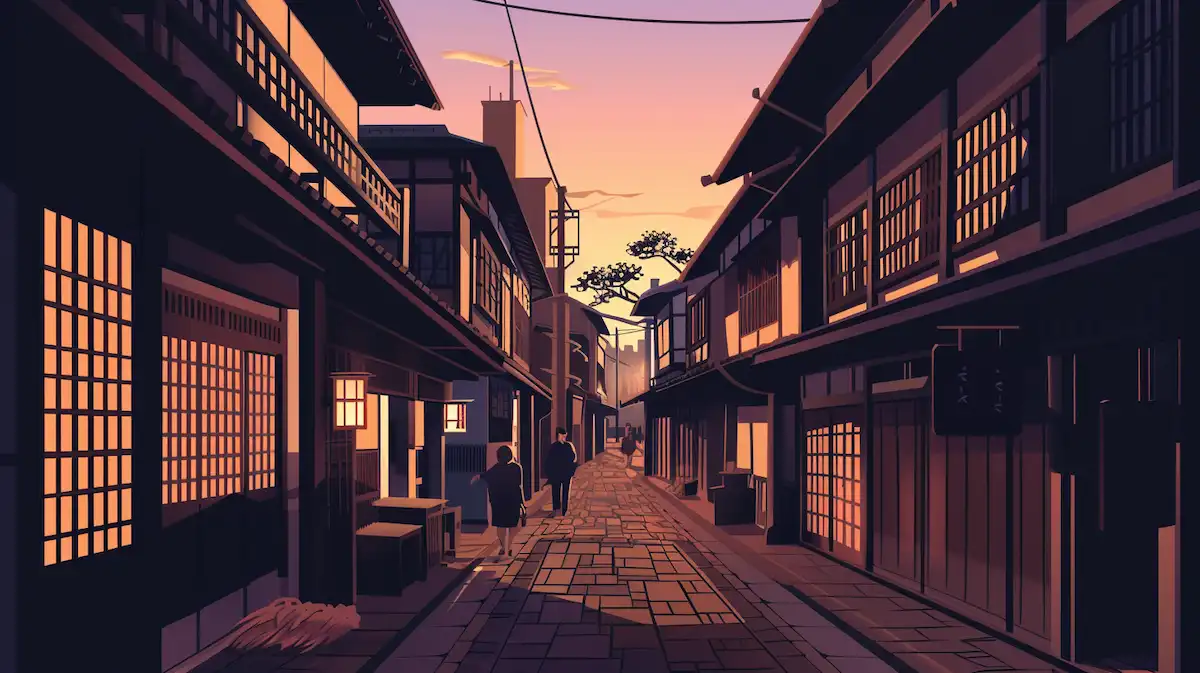深川を英語で説明・紹介するための基本情報と、英会話に役立つ表現をシンプルでわかりやすい英語で紹介します。
英会話ダイアローグ・関連情報・10の質問を通して、深川に関する英語表現を学びます。
英語
英会話ダイアローグを読む前に知っておくと良い前提知識と情報は以下の通りです。
- 深川の基本情報
- 場所: 深川は東京都江東区に位置
- 歴史: 深川は江戸時代に発展したエリアで、商業や漁業で繁栄
- 松尾芭蕉: 松尾芭蕉の住居が深川にあった。芭蕉庵史跡庭園で彼の俳句や人生が学べる
- 主な観光スポット
- 富岡八幡宮: 長い歴史を持ち、毎年8月に行われる深川八幡祭りで有名な神社
- 深川江戸資料館: 江戸時代の深川の街並みを再現している博物館
- 清澄庭園: 美しい日本庭園で、季節ごとの花や木々を楽しむことが可能
- 深川不動堂: 成田山新勝寺の別院で、多くの儀式を開催
- 地元の名物料理
- 深川めし: アサリを使った炊き込みご飯
- 深川鍋: アサリと野菜を使った鍋料理
- アクセス
- 最寄駅:東京メトロ東西線の門前仲町駅や、都営地下鉄大江戸線の清澄白河駅
2人が深川について話しています。
深川の歴史、主な観光スポット、松尾芭蕉との関わり、地元の名物料理の深川めしなどを話題にしています。
会話 / dialogue

Hey Key, I’ve been really interested in Fukagawa recently. Do you know much about it?

Yes, Fukagawa is a fascinating area in Tokyo with a lot of history. It developed during the Edo period and became famous for its commerce and fishing.

That sounds interesting. What are some of the main attractions there?

Well, one of the key attractions is Tomioka Hachimangu Shrine. It’s famous for the Fukagawa Hachiman Festival held every August. The shrine has a long history and is definitely worth visiting.

I’ve heard about that festival. What else can I see in Fukagawa?

You should definitely check out the Fukagawa Edo Museum. It recreates the streets of Fukagawa during the Edo period. It’s like stepping back in time.

That sounds amazing. I also heard that Fukagawa has a connection with Matsuo Basho. Is that true?

Yes, it is. Matsuo Basho, the famous haiku poet, lived in Fukagawa. You can visit Basho’s Hermitage and Garden to learn more about his life and work.

I love haiku! I’d definitely like to visit that place. Are there any beautiful gardens to see?

Absolutely. Kiyosumi Gardens is a beautiful Japanese garden in Fukagawa. It’s a peaceful place with seasonal flowers and trees, perfect for a relaxing stroll.

Sounds perfect for a day out. What about local food? Is there anything special to try?

Yes, you should try Fukagawa Meshi. It’s rice cooked with clams, a simple but delicious dish. Another popular dish is Fukagawa Nabe, a hot pot made with clams and vegetables.

I love trying local food when I travel. How easy is it to get to Fukagawa?

It’s very convenient. You can take the Tokyo Metro Tozai Line or the Toei Oedo Line to Monzen-Nakacho Station, and you’re right in the heart of Fukagawa.

Great, I’ll plan my trip soon. Is there anything else I should know?

Well, Fukagawa also has the Fukagawa Fudo-do Temple, which is very interesting. It’s a branch of the famous Naritasan Shinshoji Temple and has many ceremonies.

Thanks, Key. I feel like I have a good idea of what to see and do in Fukagawa now. Can’t wait to explore it!

You’re welcome, Mack. Enjoy your trip to Fukagawa!
関連情報 / related information
「深川」について、理解を深めるための「英語での関連情報」です。
深川

Introduction to Fukagawa
Fukagawa is a historic area in Koto City, Tokyo. It developed during the Edo period and became famous for its commerce and fishing. Today, Fukagawa is known for its old-town atmosphere and cultural attractions.
Historical Sites
One of the main attractions in Fukagawa is Tomioka Hachimangu Shrine. This shrine is famous for the Fukagawa Hachiman Festival held every August. The shrine has a long history and is a must-visit for anyone interested in Japanese culture. Another important site is the Fukagawa Edo Museum. This museum shows what life was like in the Edo period, with recreated streets and buildings.
Connection with Matsuo Basho
Fukagawa has a special connection with Matsuo Basho, a famous haiku poet. Basho lived in Fukagawa and wrote many haiku poems there. Visitors can learn more about him at Basho’s Hermitage and Garden. This place offers a glimpse into the poet’s life and work.
Beautiful Gardens
Kiyosumi Gardens is a beautiful Japanese garden in Fukagawa. The garden is peaceful and has many seasonal flowers and trees. It is a perfect place for a relaxing stroll and to enjoy nature.
Local Specialties
Fukagawa is also known for its delicious local food. One popular dish is Fukagawa Meshi, which is rice cooked with clams. It is a simple but tasty meal. Another specialty is Fukagawa Nabe, a hot pot made with clams and vegetables. These dishes reflect the area’s connection to the sea.
Easy Access
Fukagawa is easy to reach from central Tokyo. You can take the Tokyo Metro Tozai Line or the Toei Oedo Line to Monzen-Nakacho Station. From there, you can easily explore all the attractions in Fukagawa.
Conclusion
Fukagawa offers a mix of history, culture, nature, and food. It is a great place to visit for anyone interested in experiencing a traditional side of Tokyo. Whether you enjoy historical sites, beautiful gardens, or delicious food, Fukagawa has something for everyone.
10の質問 / 10 questions
「深川」について、理解を深めるための「英語での10の質問」です。
1: What is the Mogami River?
The Mogami River is one of the fastest rivers in Japan, located in Yamagata Prefecture. It is about 229 kilometers long and flows from the mountains to the Sea of Japan.
2: Why is the Mogami River famous?
The Mogami River is famous for its beautiful seasonal scenery, traditional boat trips, and being a subject of a famous haiku by the poet Matsuo Basho.
3: What can you see along the Mogami River?
Along the Mogami River, you can see cherry blossoms in spring, colorful autumn leaves, lush green forests in summer, and snow-covered landscapes in winter.
4: What is the Mogami River boat trip?
The Mogami River boat trip is a popular activity where you ride a traditional Japanese boat along the river, enjoying the scenic views and listening to the boatman’s songs and stories.
5: Who was Matsuo Basho?
Matsuo Basho was a famous Japanese haiku poet who traveled around Japan. He wrote a well-known haiku about the Mogami River.
6: What is the haiku that Matsuo Basho wrote about the Mogami River?
The haiku is: "The gathering summer rains rush swiftly, Mogami River." It describes the powerful flow of the river during the rainy season.
7: Are there any hot springs near the Mogami River?
Yes, there are several hot springs near the Mogami River, including Ginzan Onsen and Kaminoyama Onsen, where visitors can relax and enjoy the natural beauty.
8: When is the best time to visit the Mogami River?
The best times to visit the Mogami River are in spring for the cherry blossoms and autumn for the colorful leaves.
9: How long does the Mogami River boat trip take?
The boat trip usually takes about one hour, depending on the course you choose.
10: What should you bring when visiting the Mogami River?
When visiting the Mogami River, you should bring seasonal clothing, sunscreen, a hat, and a camera to capture the beautiful scenery.
和訳付
会話 / dialogue

Hey Key, I’ve been really interested in Fukagawa recently. Do you know much about it?
ねえキー、最近深川にすごく興味があるんだ。詳しいこと知ってる?

Yes, Fukagawa is a fascinating area in Tokyo with a lot of history. It developed during the Edo period and became famous for its commerce and fishing.
うん、深川は東京の歴史豊かな魅力的なエリアだよ。江戸時代に発展して、商業や漁業で有名になったんだ。

That sounds interesting. What are some of the main attractions there?
それは面白そうだね。主要な観光スポットにはどんなところがあるの?

Well, one of the key attractions is Tomioka Hachimangu Shrine. It’s famous for the Fukagawa Hachiman Festival held every August. The shrine has a long history and is definitely worth visiting.
そうだね、主要な観光スポットの一つは富岡八幡宮だよ。毎年8月に行われる深川八幡祭りで有名なんだ。この神社は長い歴史があって、ぜひ訪れる価値があるよ。

I’ve heard about that festival. What else can I see in Fukagawa?
その祭りのことは聞いたことがあるよ。他には深川で何が見られるの?

You should definitely check out the Fukagawa Edo Museum. It recreates the streets of Fukagawa during the Edo period. It’s like stepping back in time.
深川江戸資料館は絶対にチェックすべきだよ。江戸時代の深川の街並みを再現しているんだ。まるでタイムスリップしたみたいだよ。

That sounds amazing. I also heard that Fukagawa has a connection with Matsuo Basho. Is that true?
それは素晴らしいね。深川には松尾芭蕉とのつながりもあるって聞いたけど、本当?

Yes, it is. Matsuo Basho, the famous haiku poet, lived in Fukagawa. You can visit Basho’s Hermitage and Garden to learn more about his life and work.
そうなんだよ。俳句で有名な松尾芭蕉が深川に住んでいたんだ。芭蕉庵史跡庭園を訪れると、彼の人生や作品についてもっと知ることができるよ。

I love haiku! I’d definitely like to visit that place. Are there any beautiful gardens to see?
俳句が大好きなんだ!そこにはぜひ行ってみたいね。美しい庭園は他にあるの?

Absolutely. Kiyosumi Gardens is a beautiful Japanese garden in Fukagawa. It’s a peaceful place with seasonal flowers and trees, perfect for a relaxing stroll.
もちろん。清澄庭園は深川にある美しい日本庭園だよ。季節ごとの花や木々があって、リラックスして散歩するのにぴったりの静かな場所だよ。

Sounds perfect for a day out. What about local food? Is there anything special to try?
日帰りには完璧だね。地元の食べ物はどう?特別なものはあるの?

Yes, you should try Fukagawa Meshi. It’s rice cooked with clams, a simple but delicious dish. Another popular dish is Fukagawa Nabe, a hot pot made with clams and vegetables.
うん、深川めしを試してみて。アサリと一緒に炊いたご飯で、シンプルだけど美味しい料理なんだ。他にも人気なのは深川鍋で、アサリと野菜を使った鍋料理だよ。

I love trying local food when I travel. How easy is it to get to Fukagawa?
旅行のときに地元の食べ物を試すのが大好きなんだ。深川に行くのは簡単なの?

It’s very convenient. You can take the Tokyo Metro Tozai Line or the Toei Oedo Line to Monzen-Nakacho Station, and you’re right in the heart of Fukagawa.
とても便利だよ。東京メトロ東西線か都営大江戸線で門前仲町駅に行けば、そこが深川の中心地なんだ。

Great, I’ll plan my trip soon. Is there anything else I should know?
いいね、すぐにでも旅行の計画を立てるよ。他に知っておくべきことはある?

Well, Fukagawa also has the Fukagawa Fudo-do Temple, which is very interesting. It’s a branch of the famous Naritasan Shinshoji Temple and has many ceremonies.
そうだね、深川には深川不動堂もあって、とても興味深いよ。成田山新勝寺の別院で、たくさんの儀式が行われているんだ。

Thanks, Key. I feel like I have a good idea of what to see and do in Fukagawa now. Can’t wait to explore it!
ありがとう、キー。深川で何を見て何をするべきか、だいたいわかったよ。探検するのが待ちきれない!

You’re welcome, Mack. Enjoy your trip to Fukagawa!
どういたしまして、マック。深川の旅行を楽しんでね!
関連情報 / related information
深川

Introduction to Fukagawa
Fukagawa is a historic area in Koto City, Tokyo. It developed during the Edo period and became famous for its commerce and fishing. Today, Fukagawa is known for its old-town atmosphere and cultural attractions.
深川は、東京都江東区にある歴史的なエリアです。江戸時代に発展し、商業や漁業で有名になりました。現在、深川は古い町並みの雰囲気と文化的な観光名所で知られています。
Historical Sites
One of the main attractions in Fukagawa is Tomioka Hachimangu Shrine. This shrine is famous for the Fukagawa Hachiman Festival held every August. The shrine has a long history and is a must-visit for anyone interested in Japanese culture. Another important site is the Fukagawa Edo Museum. This museum shows what life was like in the Edo period, with recreated streets and buildings.
深川の主な観光名所の一つは富岡八幡宮です。この神社は毎年8月に行われる深川八幡祭りで有名です。神社は長い歴史を持ち、日本文化に興味がある人には必見の場所です。もう一つの重要な場所は深川江戸資料館です。この博物館では、江戸時代の生活を再現した街並みや建物を見ることができます。
Connection with Matsuo Basho
Fukagawa has a special connection with Matsuo Basho, a famous haiku poet. Basho lived in Fukagawa and wrote many haiku poems there. Visitors can learn more about him at Basho’s Hermitage and Garden. This place offers a glimpse into the poet’s life and work.
深川は、有名な俳人である松尾芭蕉との特別なつながりがあります。芭蕉は深川に住み、多くの俳句を作りました。訪問者は芭蕉庵史跡庭園で彼についてもっと学ぶことができます。この場所では、詩人の生活と仕事の一端を見ることができます。
Beautiful Gardens
Kiyosumi Gardens is a beautiful Japanese garden in Fukagawa. The garden is peaceful and has many seasonal flowers and trees. It is a perfect place for a relaxing stroll and to enjoy nature.
清澄庭園は深川にある美しい日本庭園です。この庭園は静かで、季節ごとの花や木々がたくさんあります。リラックスして散歩したり、自然を楽しんだりするのに最適な場所です。
Local Specialties
Fukagawa is also known for its delicious local food. One popular dish is Fukagawa Meshi, which is rice cooked with clams. It is a simple but tasty meal. Another specialty is Fukagawa Nabe, a hot pot made with clams and vegetables. These dishes reflect the area’s connection to the sea.
深川は美味しい地元の食べ物でも知られています。人気のある料理の一つは深川めしで、アサリと一緒に炊いたご飯です。シンプルですが美味しい料理です。もう一つの名物は深川鍋で、アサリと野菜を使った鍋料理です。これらの料理は地域の海とのつながりを反映しています。
Easy Access
Fukagawa is easy to reach from central Tokyo. You can take the Tokyo Metro Tozai Line or the Toei Oedo Line to Monzen-Nakacho Station. From there, you can easily explore all the attractions in Fukagawa.
深川は東京の中心部から簡単にアクセスできます。東京メトロ東西線または都営地下鉄大江戸線を利用して門前仲町駅に行くことができます。そこから、深川のすべての観光名所を簡単に探索できます。
Conclusion
Fukagawa offers a mix of history, culture, nature, and food. It is a great place to visit for anyone interested in experiencing a traditional side of Tokyo. Whether you enjoy historical sites, beautiful gardens, or delicious food, Fukagawa has something for everyone.
深川は歴史、文化、自然、食べ物が融合した場所です。東京の伝統的な一面を体験したい人にとって、素晴らしい訪問先です。歴史的な場所、美しい庭園、美味しい食べ物のいずれが好きでも、深川には誰もが楽しめるものがあります。
10の質問 / 10 questions
1: What is the Mogami River?
最上川とは何ですか?
The Mogami River is one of the fastest rivers in Japan, located in Yamagata Prefecture. It is about 229 kilometers long and flows from the mountains to the Sea of Japan.
最上川は日本で最も急流の一つで、山形県に位置しています。長さは約229キロメートルで、山から日本海まで流れています。
2: Why is the Mogami River famous?
最上川はなぜ有名ですか?
The Mogami River is famous for its beautiful seasonal scenery, traditional boat trips, and being a subject of a famous haiku by the poet Matsuo Basho.
最上川は美しい季節ごとの風景や伝統的な舟下り、そして俳人松尾芭蕉による有名な俳句の題材として知られています。
3: What can you see along the Mogami River?
最上川沿いでは何を見ることができますか?
Along the Mogami River, you can see cherry blossoms in spring, colorful autumn leaves, lush green forests in summer, and snow-covered landscapes in winter.
最上川沿いでは、春には桜、秋には色鮮やかな紅葉、夏には青々とした森、冬には雪景色を見ることができます。
4: What is the Mogami River boat trip?
最上川の舟下りとは何ですか?
The Mogami River boat trip is a popular activity where you ride a traditional Japanese boat along the river, enjoying the scenic views and listening to the boatman’s songs and stories.
最上川の舟下りは、伝統的な和船に乗りながら川沿いの景色を楽しみ、船頭さんの歌や話を聞く人気のアクティビティです。
5: Who was Matsuo Basho?
松尾芭蕉とは誰ですか?
Matsuo Basho was a famous Japanese haiku poet who traveled around Japan. He wrote a well-known haiku about the Mogami River.
松尾芭蕉は、日本各地を旅した有名な俳人で、最上川についての有名な俳句を詠みました。
6: What is the haiku that Matsuo Basho wrote about the Mogami River?
松尾芭蕉が最上川について詠んだ俳句は何ですか?
The haiku is: "The gathering summer rains rush swiftly, Mogami River." It describes the powerful flow of the river during the rainy season.
その俳句は「五月雨をあつめて早し最上川」です。これは、雨季における川の力強い流れを表現しています。
7: Are there any hot springs near the Mogami River?
最上川の近くに温泉はありますか?
Yes, there are several hot springs near the Mogami River, including Ginzan Onsen and Kaminoyama Onsen, where visitors can relax and enjoy the natural beauty.
はい、最上川の近くにはいくつかの温泉があり、銀山温泉とかみのやま温泉などで、訪問者はリラックスしながら自然の美しさを楽しむことができます。
8: When is the best time to visit the Mogami River?
最上川を訪れるのに最適な時期はいつですか?
The best times to visit the Mogami River are in spring for the cherry blossoms and autumn for the colorful leaves.
最上川を訪れるのに最適な時期は、春の桜と秋の紅葉です。
9: How long does the Mogami River boat trip take?
最上川の舟下りはどれくらいの時間がかかりますか?
The boat trip usually takes about one hour, depending on the course you choose.
舟下りは通常約1時間かかりますが、選ぶコースによって異なります。
10: What should you bring when visiting the Mogami River?
最上川を訪れる際に持っていくべきものは何ですか?
When visiting the Mogami River, you should bring seasonal clothing, sunscreen, a hat, and a camera to capture the beautiful scenery.
最上川を訪れる際には、季節に応じた服装、日焼け止め、帽子、美しい景色を撮影するためのカメラを持っていくと良いでしょう。
words & phrases
英会話ダイアローグと関連情報に出てきた単語・フレーズです(例文は各3つ)。

commerce : 名詞
意味: 商業、貿易。The activity of buying and selling, especially on a large scale.
(深川が江戸時代に商業で栄えたことを指す)
例文:
Commerce between the two countries has increased.
「両国間の商取引が増加しました。」
The city is a center of commerce and industry.
「その都市は商業と工業の中心地です。」
They studied the history of commerce in school.
「彼らは学校で商業の歴史を学びました。」
hermitage : 名詞
意味: 隠遁者の住まい、庵。A place where a hermit lives, often a secluded and simple dwelling.
(松尾芭蕉が住んでいた場所、芭蕉庵を指す)
例文:
He retired to a hermitage in the mountains.
「彼は山中の庵に引退しました。」
The hermitage was small but peaceful.
「その庵は小さかったが、平和でした。」
Visitors can tour the poet’s hermitage.
「訪問者は詩人の庵を見学できます。」
stroll : 動詞
意味: ぶらぶら歩く、散策する。To walk in a slow, relaxed manner, especially for pleasure.
(清澄庭園でのリラックスした散策を指す)
例文:
They strolled through the park in the evening.
「彼らは夕方に公園を散策しました。」
We decided to stroll around the town.
「私たちは町をぶらぶら歩くことにしました。」
She loves to stroll by the river.
「彼女は川沿いを散策するのが大好きです。」
clams : 名詞
意味: アサリ、ハマグリなどの二枚貝。A type of shellfish with a shell divided into two parts.
(深川めしや深川鍋の主要な材料としてのアサリを指す)
例文:
We had clams for dinner.
「私たちは夕食にアサリを食べました。」
She collected clams on the beach.
「彼女は浜辺でアサリを集めました。」
Clams are often used in seafood dishes.
「アサリはしばしば海鮮料理に使われます。」
glimpse : 名詞
意味: 一瞬の見ること、ちらりと見ること。A brief or quick view or look.
(芭蕉庵で詩人の生活や仕事の一端を見ることを指す)
例文:
I caught a glimpse of the famous actor.
「私は有名な俳優をちらりと見ました。」
The book offers a glimpse into his life.
「その本は彼の生活の一端を垣間見ることができます。」
She gave me a quick glimpse of her artwork.
「彼女は自分の作品をちらりと見せてくれました。」
